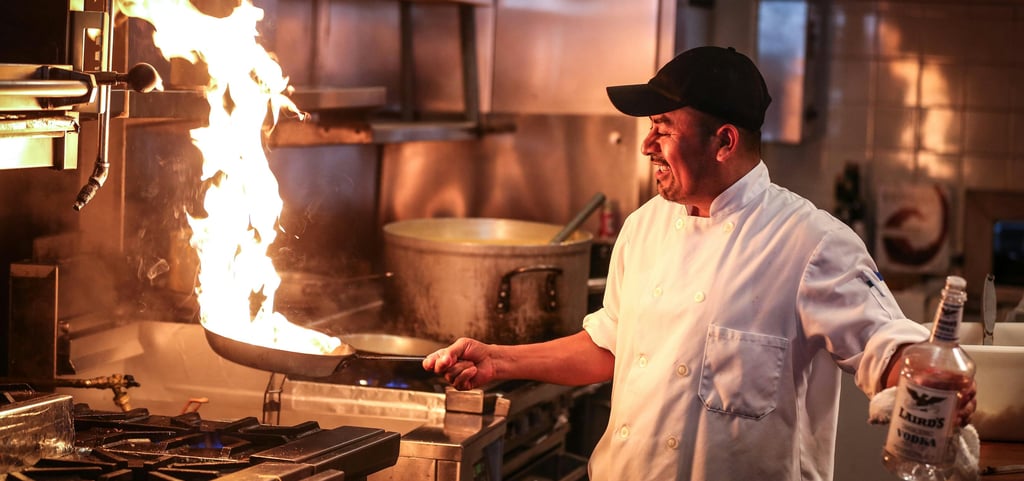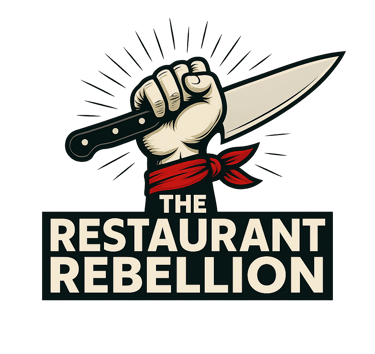The Restaurant Owner’s Guide to Content Marketing
A practical guide for restaurant owners to systemize content marketing, boost visibility, and stay consistent without adding more to your plate.
Michael Westhafer
10/4/20256 min read


Running a restaurant means juggling everything — employees, vendors, reservations, inventory, and ensuring a great guest experience. Marketing? It can easily end up at the bottom of your daily to do list.
That’s why so many restaurant owners find themselves with:
An occasional Facebook post that they scramble to put together- when they remember to do it.
An email blast sent out just before the holidays, but hardly ever in between.
A website that hasn’t been updated since the hours changed during covid.
Sound familiar?
You’re not alone, and the truth is: your marketing isn’t failing because you don’t care. It’s failing because you don’t have a repeatable system in place to ensure it gets done, and done well.
The Nuts and Bolts of a Marketing System That Will Fix This for You
If you’ve been nodding your head so far, you already know the problem isn’t that you’re not trying to do marketing. It’s that you’re doing it without a system.
Think about it: you’d never run your kitchen without recipes, prep lists, or employee schedules. Why? Because chaos kills consistency. The same is true for your marketing.
A real system:
Take the randomness out of when and where you post.
Keeps Google and your guests hearing from you consistently.
Turns “marketing” from a burden into a repeatable process.
And here’s the best part: the basics are fairly simple. You don’t need a marketing degree or a giant ad budget. You just need a framework that tells you what to say, where to say it, and when to put it out there.
That’s what we’ll build next. Lets start with understanding the foundation of all of your marketing - content.
What “Content” Actually Means in a Restaurant
When marketers say “content,” it can sound confusing or abstract. But for restaurants, content is simply how you stay connected with guests outside your four walls.
Here’s what content is -
Social Media Posts – the Facebook, Instagram, or TikTok you are already posting is social content.
Email & SMS Campaigns – bulk messages to your guest list (usually pulled from your POS, online orders, or reservations system). Many restaurants already have this list but rarely use it — even though it’s one of the most powerful ways to get guests back in the the restaurant more often.
Google Business Profile (GBP) Posts – a hidden gem. Short updates posted on your Google Business Profile can massively boost your visibility in local search. This has a big impact on the other marketing concept that draws blank stares - SEO (seriously, it's not as complicated as it may seem).
Website “News/Updates” Page – most restaurants treat their website like a “fire and forget” brochure and never touch it again. But adding quick, consistent updates gives Google (here we go with the SEO again) a reason to keep sending people your way. Most website hosting platforms offer the ability to post blogs, and this is where you post these updates.
If you’ve done even bits of this, you might be thinking:
“Oh, I’m already doing some of this… I just don’t have a ‘system’.”
Exactly.
The next mystical concept we are going to expose is how to organize your content into themes. In professional marketing circles (trying not to giggle as I write that…), we call these themes content pillars.
How to Define your Marketing Pillars
In an effort to not flood you with a bunch of new marketing jargon, I will only introduce the necessary ones, and then you can call them whatever you like. For the purpose of your marketing plan/system, we will talk about how to create your content Pillars. Your pillars are just the themes guests want to see from you: food, people, experiences, and what makes your place unique behind the scenes
In the beginning, I would advise you to keep this simple. Start with four basic pillars/themes, and as you go, add more as it makes sense for your restaurant:. Here are four pillars to get you started:
Menu Highlights – showcase dishes, drinks, specials
Team Stories – spotlight your people and culture
Guest Experiences – reviews, events, celebrations, community
Behind-the-Scenes – prep, sourcing, process, kitchen moments
Once you see content through the lens of Pillars, it stops being random posts and starts becoming key elements within your repeatable system.
The Roadblock: No System = No Consistency
This is where most owners get stuck. Without a system, marketing always slips to the bottom of the list.
That looks like:
Social posts only when you have a spare minute.
Emails/texts sent in bursts around holidays.
Google profile updated only when hours change.
Website left untouched for years.
The problem? Inconsistent communication = inconsistent results.
Even worse — inconsistency kills visibility.
Social platforms reward consistency by showing your posts to more people.
Google rewards fresh content by ranking your restaurant higher in local search.
Climbing into the Top 3 search results for “restaurant + your location” is how you win the game — and you don’t get there without regular updates.
This isn’t a creativity problem. It’s a capacity problem. Without a repeatable process, even the best ideas get lost in the chaos of daily operations.
What Systemization Really Means
Systemization doesn’t mean spending thousands on software, influencers, or hiring a marketing agency. For a restaurant owner, it simply means turning content into a repeatable process — like a recipe in your kitchen.
The core pieces:
Strategy – Decide what stories matter most.
Calendar – One central plan for when and where things go out.
Templates – Reusable formats so you’re not starting from scratch.
Batching – Do the work in chunks so one session covers the whole week.
Once those are in place, marketing stops being a scramble and starts running like any other system in your business.
The Owner’s Role
Here’s the good news: you don’t need to be the one posting every day.
Your role is to:
Set the Pillars → decide the themes and stories that matter.
Review the Plan → make sure the calendar lines up with promotions and goals.
Drop Content into the System → a couple of hours capturing photos, video, or notes is all it takes.
At first, you might run the system yourself. With a simple planner, it doesn’t take more than a couple of hours a week.
Long term, you can delegate execution to a trusted team member. That’s how you protect your quality of life while keeping marketing consistent.
The Quick Start Framework
Identify Your Pillars → Start with four: Menu Highlights, Team Stories, Guest Experiences, Behind-the-Scenes.
Plan 4 Weeks in a Calendar → Use a simple content planner.
3–4 social posts per week per platform (see thoughts below about social platforms) - spread across your Pillars
1 email and/or text campaign per week (engage with your list)
1 GBP update per week (short, simple, SEO power)\
1 website update per week (short, simple, SEO power)
Batch Your Content → Spend 1–2 hours capturing and dropping content into your calendar.
Send Your Campaign → Use that email/text list from your POS to invite guests back.
Publish Updates → Keep Google checking your site and profile weekly.
That’s it. In just a couple of focused hours, you’ve built a repeatable system that boosts visibility and keeps your restaurant top of mind.
Deep Thoughts on Social Media -
Many small businesses try to be everywhere all the time and this can be exhausting and counterproductive. If you are trying to be on more than two or three social media platforms, you're probably not very effective on any.
The best approach is to go narrow and deep with the ones that you get the most interaction with your customers and people that are like your customers (aka potential customers). If that's just Facebook and Instagram, that's ok. If you want to try out Tik Tok and it works for you and your brand- go for it.
The idea you have to be on Youtube, Pinterest, Snapchat, and the one that used to be called Twitter, is not healthy for you or your business. You will burn out and there goes any hope of consistency.
If you are not sure which ones you should be on, ask your customers and see where they spend the most time online. Put effort into being relevant and consistent where your customers are.
Closing: How We Can Help
Most restaurant owners don’t need more marketing ideas — they need a system that keeps the good ideas moving, week after week.
That’s why we built two tools designed to work for you wherever you are in your business journey.:
The Restaurant Rebellion Content Planner (Free Download)
Start here if you’re ready to bring structure and rhythm to your marketing.
This simple Google Sheet helps you:
Map your 4 Marketing Pillars — the themes your stories come from
Plan out a full month of social posts, emails, and updates
Stay organized and consistent without overthinking what comes next
It’s the perfect first step to getting your content under control and your calendar working for you.
REBEL ONE
If having your system fully automated so it is sending out your content at the right time, then REBEL ONE is your jam — and that's only part of its capabilities.
You load in your content: photos, captions, and updates. REBEL ONE handles the rest:
Schedules and sends content across your connected channels
Keeps your posting consistent (even when things get busy)
Ensures your Google, social, and email presence keeps running like clockwork
Think of it as your marketing system on autopilot — built for restaurant life. You create the content, REBEL ONE delivers it at the right time, every time.
Where to Start
Grab the Restaurant Rebellion Content Planner and start organizing your stories around your 4 Pillars. Free Download Here.
If you’re ready to let the system take it from there — REBEL ONE is ready to run your schedule automatically so you can focus on running your restaurant. See REBEL ONE Here


